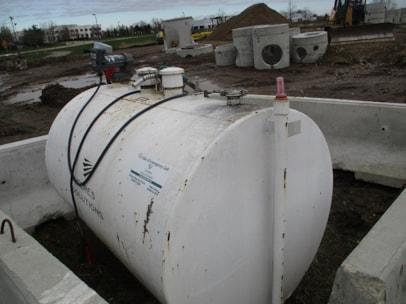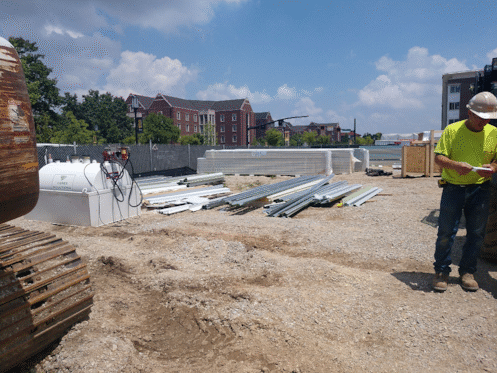"Whether use of double-walled tanks meets the requirement in §1926.152(e)
that tanks be protected from collision damage"

The Occupational Safety and Health Administration (OSHA) has received thousands of questions and requests for clarification about their occupational health and safety standards from employers, individuals, unions, and other organizations throughout the years. When OSHA responds to these questions, they typically do so through a Letter of Interpretation. These letters are posted on the OSHA website and address many topics; they are a great resource for employers because they may answer your question(s) about a particular standard or topic. However, be aware that the letters only address the specific question asked and may not apply to your exact situation. Also, the letters are strictly interpretations issued by OSHA, and do not alter the meaning of the actual OSHA standards. The intent of this newsletter series will be to provide insight into some of the more unique interpretations provided by OSHA.
This article (Part VII) will address whether use of double-walled tanks meets the requirement in §1926.152(e) that tanks be protected from collision damage.
Question: Section §1926.152(e)(4) provides that, with respect to dispensing flammable and combustible liquids, "The dispensing units shall be protected against collision damage." If a fuel tank has double walls, are barriers or other devices required to meet the requirements of this provision?
OSHA responded that under 29 CFR §1926.152(e)(4), While double walls reduce the chance of a tank rupture from a collision, it does not necessarily eliminate the combustion/explosion hazard from collisions addressed by the standard. For example, the location and design of equipment attached to the tank may render the system equally vulnerable irrespective of whether the tank is single or double-walled. The extent of the measures required to meet this requirement depends upon the nature of the collision risk where the unit is located. For example, more extensive measures would be required for a refueling tank located next to a roadway or other high traffic area than for a system located in an area used only by vehicles approaching for filling operations.
As you can see, the answer OSHA originally provided to the questioner in this case left room for significant ambiguity. The questioner then responded with a follow-up questions that asked the following:
Follow-up question: "In your April 29 follow-up letter, you ask us (OSHA) to more definitively state whether the use of a double-walled tank supplants a need for any additional measures, such as barricades, for preventing collision damage.”
OSHA responded with the following: “In general, the fact that a tank is double-walled would not, by itself, be sufficient to meet the requirements of §1926.152(e)(4), for the reasons stated in our previous letter. The extent of other measures required depends on factors such as the proximity of the tank to high volume or high-speed traffic, as previously discussed. Other factors such as whether vehicles back up to the tank (posing a higher collision risk) are also relevant.
Typically, where collision risk is very low (such as a separate refueling area in which: traffic is limited to refueling vehicles, there is plenty of maneuvering room, there is low traffic volume and speed, and backing-up to the tank is not necessary), some form of visual warning that marks an approach boundary would be required, irrespective of whether the tank was double-walled. Where collision risk is higher, more substantial measures would be required.
In sum, the fact that a tank is double-walled typically would be insufficient by itself to meet the requirement in §1926.152(e)(4) for protection against collision damage.”
For the purpose of discussion, let’s look at 2 scenarios in which barricading could potentially be required under OSHA’s interpretation letter that we have discussed. I will then give my opinion on each of these scenarios from a safety compliance standpoint.
Scenario #1 – Diesel tank without spill containment located near the middle of the site.

This scenario pictures a standard set-up for a diesel re-fueling station and has been barricaded with jersey barriers on all four sides. There appears to be traffic all around this station and the tank also is not equipped with spill containment. Without these jersey barriers it is my opinion that this would be an OSHA violation per §1926.152(e)(4). This is due to the factors previously mentioned, such as location, potential for damage and the amount of traffic near this area.
Can you spot another potential violation with this set-up? The tank from this angle appears to be missing all of the required labeling/signage for tanks of this sort. Now to scenario #2.
Scenario #2 – Diesel tank with spill containment system in place, located near fence line onsite.

This scenario shows a diesel refueling station that does not have hard barricades in place but is placed near the fence line of the project and set in an area that is approximately 20’ from any major roadway or high traffic area. This tank does have a spill containment system installed and this tank location does not require for machines to back-up into the refueling area. While hard barricades may be a best practice in this circumstance, it is also a prime example of the ambiguity of the standard. While this system most likely meets compliance guidelines in its current configuration, the safe bet would be to recommend that some form of visual indicator be implemented to mark an approach boundary. This recommendation would ensure compliance, while not requiring the same type of barricading as outlined within scenario #1.
At what point do we, as Safety Directors or Competent People, take the extra step to improve upon an already compliant system? Think about that question and think about the individual scenarios as they arise. If some forethought or planning has been documented/implemented, you may be able to avoid an OSHA citation or an incident at a later date.
Cited Source: OSHA.gov. (2019). Use of double-walled tanks as the only form of protection from collision damage. | Occupational Safety and Health Administration. [online] Available at: https://www.osha.gov/laws-regs/standardinterpretations/2002-12-31 [Accessed 26 Aug. 2019].

& Director of Client Development
090319
Related Topics: The Consultant's Corner